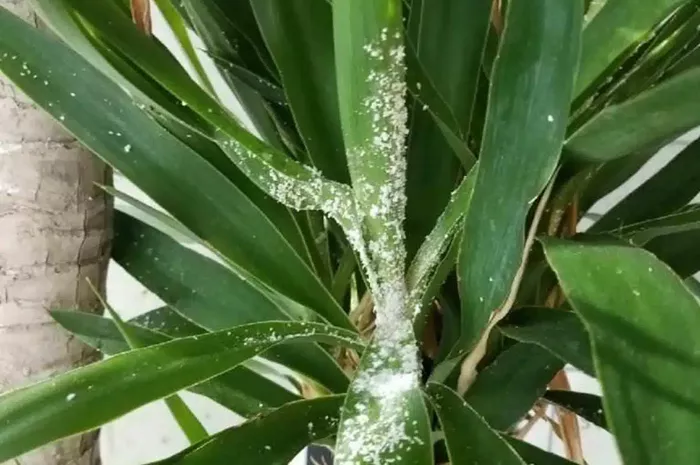Mealybugs are one of the most common and frustrating pests that plague houseplants and garden plants. These small, white, cottony insects can quickly multiply and weaken your plants if left untreated. But where do they come from, and why do they attack certain plants? In this article, we’ll explore the main causes of mealybug infestations and how to prevent them.
What Are Mealybugs?
Identifying Mealybugs
Mealybugs are soft-bodied insects that belong to the scale insect family. They’re easily recognized by their:
- White, cotton-like wax coating
- Oval shape (about 1/8 inch long when adult)
- Clustering habit (often found in groups)
Common Types of Mealybugs
There are several species that affect plants:
- Citrus mealybug (Planococcus citri)
- Longtailed mealybug (Pseudococcus longispinus)
- Root mealybug (Rhizoecus spp.)
The Main Causes of Mealybug Infestations
1. Bringing Home Infested Plants
The most common way mealybugs spread is through:
- Newly purchased plants
- Gift plants
- Plants brought indoors for winter
Prevention Tip: Always quarantine new plants for 2-3 weeks before placing them near others.
2. Poor Plant Health
Weak or stressed plants are more vulnerable because:
- They produce less defensive chemicals
- Their growth is slower, making it harder to outgrow damage
- Their sap composition changes, becoming more attractive to pests
Common stressors include:
- Overwatering or underwatering
- Poor lighting conditions
- Nutrient deficiencies
- Root-bound plants
3. Warm, Dry Conditions
Mealybugs thrive in:
- Temperatures between 70-90°F (21-32°C)
- Low humidity environments
- Stagnant air conditions
This explains why they’re common in:
- Indoor plants year-round
- Outdoor plants in summer
- Greenhouses
4. Overuse of Nitrogen Fertilizers
Excess nitrogen leads to:
- Soft, succulent growth that’s easier for mealybugs to pierce
- More amino acids in plant sap (a mealybug favorite)
- Reduced production of defensive compounds
5. Lack of Natural Predators
Indoors and in controlled environments, mealybugs multiply quickly because:
- Ladybugs, lacewings and parasitic wasps are absent
- There’s no rain to wash them off
- Temperatures remain constant
6. Ant Activity
Ants “farm” mealybugs by:
- Protecting them from predators
- Moving them to new plants
- Feeding on their honeydew secretions
How Mealybugs Damage Plants
Feeding Process
Mealybugs harm plants by:
- Inserting needle-like mouthparts into plant tissue
- Sucking out sap (plant juices)
- Injecting toxic saliva
Visible Symptoms
Look for these warning signs:
- Yellowing or curling leaves
- Sticky honeydew on leaves
- Black sooty mold (grows on honeydew)
- Stunted growth
- Leaf drop
Life Cycle of Mealybugs
Understanding their reproduction helps control them:
Egg Stage
- Laid in cottony egg sacs
- 100-600 eggs per female
- Hatch in 7-10 days
Nymph Stage (Crawlers)
- Mobile and spread to new plants
- Develop through 3 instars
- Lasts 6-9 weeks
Adult Stage
- Females live 2-3 months
- Some species reproduce without males
- Can produce multiple generations per year
High-Risk Plants
Mealybugs prefer certain plant families:
Most Vulnerable Plants
- Citrus trees
- Orchids
- Succulents
- Hibiscus
- Gardenias
- Philodendrons
- Coleus
- Poinsettias
Less Common Targets
- Herbs
- Vegetables
- Grasses
Prevention Strategies
Cultural Controls
- Inspect plants regularly – Check leaf axils and undersides
- Maintain proper spacing – Avoid overcrowding
- Control ants – Use sticky barriers or baits
- Prune properly – Remove infested parts immediately
- Boost plant health – Provide optimal growing conditions
Environmental Controls
- Increase air circulation
- Maintain moderate humidity (40-60%)
- Avoid temperature extremes
- Use fans to disrupt pest movement
Biological Controls
Introduce natural predators:
- Cryptolaemus montrouzieri (mealybug destroyer)
- Green lacewings
- Parasitic wasps (Leptomastix spp.)
Treatment Options
Least Toxic Methods First
- Manual removal – Use cotton swabs dipped in alcohol
- Water spray – Blast them off with a strong stream
- Insecticidal soap – Effective on contact
- Neem oil – Disrupts their life cycle
Chemical Controls (Last Resort)
- Systemic insecticides (imidacloprid)
- Contact sprays (pyrethrins)
- Always follow label instructions
Common Mistakes That Spread Mealybugs
What Not to Do
- Ignoring early signs
- Using dirty pruning tools
- Overwatering treated plants
- Applying pesticides incorrectly
- Moving infested plants
Long-Term Management
Monitoring Plan
- Weekly inspections
- Sticky traps for crawlers
- Magnifying glass for eggs
Quarantine Protocol
- 3-week isolation for new plants
- Separate treatment area
- Different tools for infected plants
Conclusion
Mealybug infestations typically start from introduced plants, environmental conditions favoring their spread, and weakened plant defenses. By understanding these causes and implementing preventive measures, you can protect your plants from these persistent pests. Remember that early detection and consistent treatment are key to successful control.


